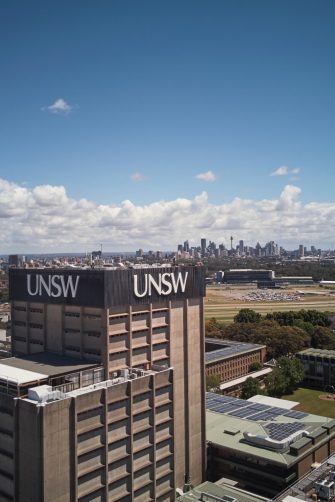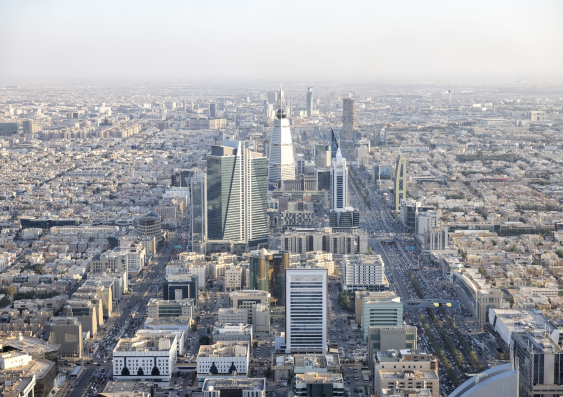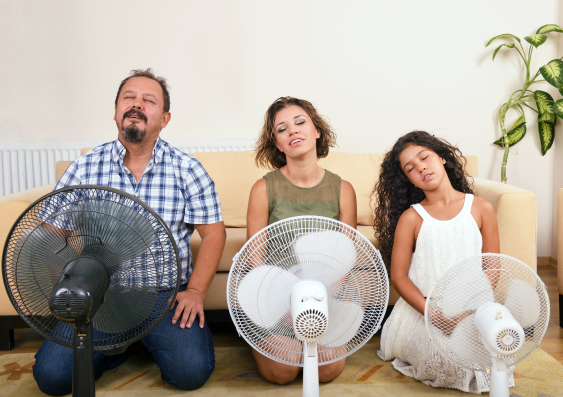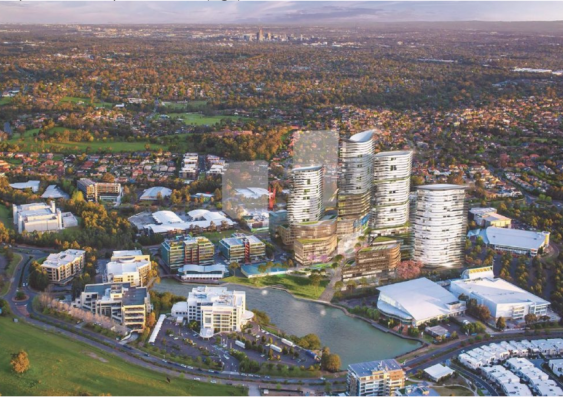Our smart campus provides healthy conditions and showcases cutting-edge technologies in our research and teaching.
A multidisciplinary research group at UNSW has transformed the Kensington campus into a living lab to help combat heat exposure in our cities. Urban overheating is a major challenge impacting the sustainability and liveability of our cities, says Dr Negin Nazarian from the School of Built Environment at UNSW Arts, Design & Architecture.
“With 90 per cent of the population residing in urban areas, more than 10 million Australians already live in areas classified with high to hazardous heat risks. This relentless heat, often dubbed a ‘silent killer,’ claims more lives than any other natural disaster,” she says.
“Without effective mitigation efforts, the economic, social and health costs associated with heat could soar by more than 400 per cent from current levels. At UNSW, we’re integrating advanced modelling with smart sensors across campus to measure and analyse local urban climate challenges, such as urban heat, ventilation, energy and air quality.”
Dr Nazarian is an award-winning urban climatologist, Chief Investigator at the ARC Centre of Excellence for Climate Extremes, and Fellow at the City Futures Research Centre at UNSW. She leads the UNSW Climate-Resilient Cities (CRC) Lab that tackles urban heat and air quality issues. Its expertise spans mechanical engineering, climate science, architecture and advanced data analytics.
Media enquiries
For enquiries about this story and interview requests, please contact Ben Knight, News & Content Coordinator, UNSW Arts, Design & Architecture.
Phone: (02) 9065 4915
Email: b.knight@unsw.edu.au
The CRC lab uses established and emerging methods, such as modelling and sensing, to produce multi-scale climate mapping of cities to inform urban design and planning. Dr Nazarian’s team has conducted three-dimensional modelling of airflow and heat on campus and developed a digital twin – a virtual replica – of the Anita B. Lawrence Building (formerly the Red Centre) which operates as an advanced monitoring system for its indoor environments.
Their campus living lab aims to improve heat exposure and air quality in different indoor and outdoor campus environments. More than 100 sensors were installed in teaching spaces, meeting rooms, open-plan and individual offices to measure parameters, including carbon dioxide, volatile organic compounds (VOCS – indoor air pollutants), noise levels, lighting, temperature and humidity.
“Establishing our campus as a living lab allows us to showcase cutting-edge technologies in our research and teaching and help demonstrate how they can be used to provide healthy and comfortable conditions on campus,” she says. “3D modelling enables us to visualise urban climate challenges on campus, while the digital twin provides an enhanced real-time insight into the environmental status of the building spaces via the sensors’ live feed.”
The campus living lab project builds on the rise of internet-enabled, citizen-science solutions – known as the Internet of Things (IoT) – as well as high-resolution satellite imagery over the past decade. These methods enable the collection and sharing of real-time or fine-grained climate data across different urban areas. Crowdsourcing and processing this data provide valuable insights into urban climates.
“The sheer number of crowdsourced weather stations available can provide a high-resolution understanding of the variability of urban heat that is not possible to obtain via traditional networks,” she says.
The CRC Lab also works with satellite datasets, such as Landsat 8 and MODIS. “By ‘layering’ this information with the increasing number of datasets available around the three-dimensional structure of cities – their vegetation, urban forms and geographies – we can better understand how the built environment interacts with climate and its impact on people.”
The lab partners with global experts, government and industry, including the Australian Urban Research Infrastructure Network (AURIN) and Google, and engages undergraduate, postgraduate and higher degree research students on research projects and climate-intervention strategies.
Overheating is driven by the climate crisis and exacerbated by urban development.
Its research prioritises a human-centred approach, addressing personalised characteristics of heat exposure rather than one-size-fits-all solutions and guidelines. This can inform us when, where, and who is most impacted by urban heat and provide fine-scale solutions for addressing this challenge, she says.
“Overheating is driven by the climate crisis and exacerbated by urban development. It represents a multi-faceted challenge that impacts the well-being, performance and health of individuals,” she says. Vulnerability to urban heat is exacerbated when sensitive people and infrastructure are exposed to extreme heat in a way that means they’re unable to adapt, she says.
“Our focus on the human scale allows us to consider issues of heat exposure and thermal comfort within an equity framework – a framework that considers not just the urban environment, or heat as a hazard, but parameters such as affluence, health and capacity to adapt,” she says.
“Our multidisciplinary approach demands solutions that help mitigate heat exposure, reduce sensitivities and increase the adaptive capacities of specific populations.”
Advancing indoor air quality and thermal comfort
Dr Nazarian has led an initial study into the indoor thermal comfort and air quality in the Anita B. Lawrence Building, using the IoT sensor network. Indoor air pollution impairs cognitive functions, damages the nervous system, increases stroke risk, depression, and mood disorders.
“In Australia, like most developed nations, we spend most of our time – an estimated 90 per cent – indoors,” Dr Nazarian says. “This is set to increase in the coming decades as public space decreases with the deterioration of urban liveability and escalating overheating and extreme weather events.”
Having favourable indoor environments that promote sustained attention, productivity, and physical and mental health is fundamental to providing a quality educational experience, she says. “However, many learning facilities employ one-size-fits-all solutions across highly diverse educational environments.”
Additionally, most studies rely on outdoor measurements or consider limited areas and time periods, she says. “This makes it hard to establish the relationship between internal conditions, seasonal anomalies and extreme weather conditions, and other variables, such as spatial occupancy.”
Data was collected during a 15-month period that spanned standard building occupancy and seasonal change as well as the Black Summer bushfires (2019) and the COVID-19 lockdown (2020). In addition to the IoT sensor network, outdoor data was collated from a weather and air-quality monitoring station less than two kilometres away to investigate correlations between indoor-outdoor conditions.
“COVID [lockdowns, when the facilities were empty,] provided us with a useful benchmark from which to analyse other usage patterns, and the Black Summer bushfires, an extreme weather event, to enable us to deliver site-specific re-design guidelines to improve the building’s climate resilience.”
The accumulation of heat and pollutants, such as carbon dioxide and VOCs, varied depending on a room’s elevation, floor level, windows and use, the study found. Additionally, passive ventilation systems based on manual interventions were likely to produce sub-optimum environmental quality and extreme variability linked to occupancy patterns.
“During periods of extreme pollution and intermittent disuse, closed environments tended to become very unhealthy,” she says. “Most of the recorded environmental inefficiencies or health threats could be mitigated by implementing automated controls and smart logics to maintain adequate cross ventilation and appropriate air filtration.”
The study, which was used to improve the building’s conditions, offers a roadmap for moving towards more resilient and healthy educational buildings. “The study supports the need for the continuous monitoring of learning spaces to compensate for less perceivable threats, identify improvements and future-proof our learning environments.”









